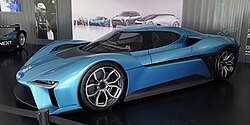NOK EP9
| NOK | |
|---|---|
| EP9 | |
| Production period: | since 2016 |
| Class : | Sports car |
| Body versions : | Coupe |
| Engines: |
Electric motor : 1 MW |
| Length: | 4888 mm |
| Width: | 2230 mm |
| Height: | 1150 mm |
| Wheelbase : | |
| Empty weight : | 1735 kg |
The NIO EP9 is an electrically powered , two-seater super sports car . Manufactured at NIO with the participation of the company's Formula E division, it holds several speed records.
history
The EP9 was developed in just 18 months and presented to the public in November 2016 at the Saatchi Gallery in London .
Six EP9s were sold to NIO investors for $ 1.2 million each . Ten more EP9s are currently being built and are to be sold to interested parties.
Technical specifications
Each EP9 wheel has its own motor and gear ratio. Each engine has an output of 250 kW; together they add up to 1000 kW. The EP9 can either be driven in all-wheel drive mode or by direct selection of the drive wheels. The super sports car has a torque distribution system that measures the torque per wheel. The battery capacity is designed for up to 427 km. A charging process takes around 45 minutes.
The EP9 is equipped with an active wheel suspension, including a computer-controlled height control that carries out 200 calculations per second.
The brakes on the EP9 were designed by NextEV.
The chassis is made of carbon fiber reinforced plastic (KfK) and is based on the FIA's technical regulations for prototypes at the 24 Hours of Le Mans . The outer skin is also made of KfK. The batteries weigh 635 kilograms, the weight of the KfK components adds up to 364 kilograms. The total weight of the EP9 is given as 1735 kilograms.
power
The EP9 accelerates from zero to 100 km / h in 2.5 seconds and reaches 200 km / h in 6.0 seconds. The vehicle is 300 km / h fast after 15.9 seconds. The maximum speed is given as 313 km / h.
design
Exterior
The rear wing of the EP9 can be adjusted to three positions: park position, low downforce and high downforce. At a speed of 240 km / h the downforce is 24.47 kilonewtons , 200 percent more than a Formula 1 racing car. The maximum lateral acceleration is around 3 g .
interior
Like the body and the chassis, the interior also consists of a CFRP structure. There are four monitors: one each at the driver's and front passenger's perspective, one in the console between the two seats and one in the steering wheel.
- Monitors in front of the driver and front passenger - both show the performance data, but work differently. Only four values are shown on the passenger side: speed, lap time, lateral acceleration in G and the driver's heart rate.
- Monitor in the center console - this shows performance data and lap times, as well as a route map with the current position of the car.
- Steering Wheel Monitor - This is a simplified version of the steering wheel used in NextEV's Formula E monoposto.
World records
The EP9 drove the second fastest lap time on the Nürburgring's Nordschleife that an exclusively electrically powered car has ever driven there. Only a modified McLaren P1 LM was even faster. Overall, he has the sixth fastest time there. The EP9 holds lap records on the Paul Ricard circuits in France, on the Circuit of The Americas in Texas, USA and on the Shanghai International Circuit . On the Circuit of the Americas, the EP9 even marked a record lap for autonomously controlled cars.
| route | Lap time |
|---|---|
| Nürburgring Nordschleife | 6: 45.90 |
| Circuit Paul Ricard | 1: 52.78 |
| Circuit of The Americas | 2: 11.39 (driver)
2: 40.33 (auto) |
| Shanghai International Circuit | 2: 01.11 |
| Goodwood Festival | 0: 44.61 |
See also
Web links
Individual evidence
- ↑ DPCcars: NextEV NIO EP9 With 1341 Horsepower Unveiling. November 22, 2016, accessed October 12, 2017 .
- ↑ Wired.co.uk, White J .: NextEV's NIO EP9 is an incredible four-wheel-drive electric hypercar. Wired.co.uk., November 21, 2016, accessed October 12, 2017 .

